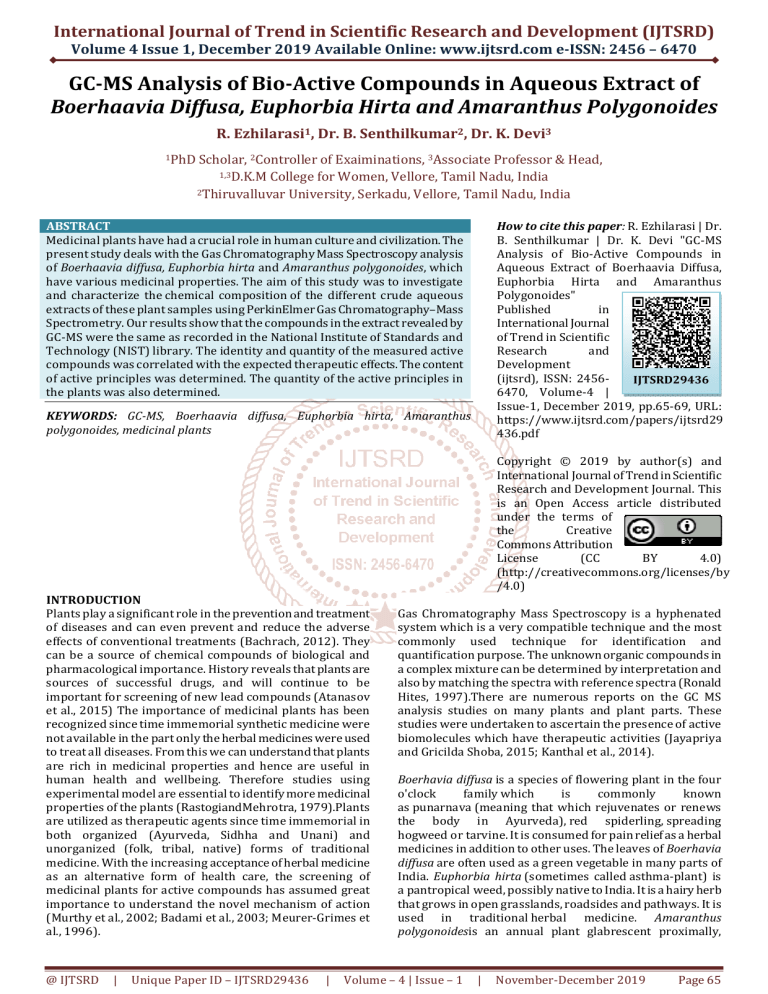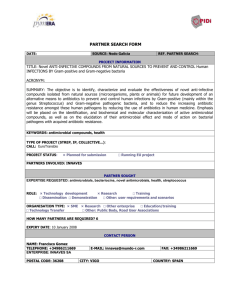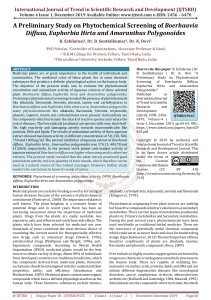
International Journal of Trend in Scientific Research and Development (IJTSRD)
Volume 4 Issue 1, December 2019 Available Online: www.ijtsrd.com e-ISSN: 2456 – 6470
GC-MS Analysis of Bio-Active Compounds in Aqueous Extract of
Boerhaavia Diffusa, Euphorbia Hirta and Amaranthus Polygonoides
R. Ezhilarasi1, Dr. B. Senthilkumar2, Dr. K. Devi3
1PhD
Scholar, 2Controller of Exaiminations, 3Associate Professor & Head,
1,3D.K.M College for Women, Vellore, Tamil Nadu, India
2Thiruvalluvar University, Serkadu, Vellore, Tamil Nadu, India
ABSTRACT
Medicinal plants have had a crucial role in human culture and civilization. The
present study deals with the Gas Chromatography Mass Spectroscopy analysis
of Boerhaavia diffusa, Euphorbia hirta and Amaranthus polygonoides, which
have various medicinal properties. The aim of this study was to investigate
and characterize the chemical composition of the different crude aqueous
extracts of these plant samples using PerkinElmer Gas Chromatography–Mass
Spectrometry. Our results show that the compounds in the extract revealed by
GC-MS were the same as recorded in the National Institute of Standards and
Technology (NIST) library. The identity and quantity of the measured active
compounds was correlated with the expected therapeutic effects. The content
of active principles was determined. The quantity of the active principles in
the plants was also determined.
How to cite this paper: R. Ezhilarasi | Dr.
B. Senthilkumar | Dr. K. Devi "GC-MS
Analysis of Bio-Active Compounds in
Aqueous Extract of Boerhaavia Diffusa,
Euphorbia Hirta and Amaranthus
Polygonoides"
Published
in
International Journal
of Trend in Scientific
Research
and
Development
(ijtsrd), ISSN: 2456IJTSRD29436
6470, Volume-4 |
Issue-1, December 2019, pp.65-69, URL:
https://www.ijtsrd.com/papers/ijtsrd29
436.pdf
KEYWORDS: GC-MS, Boerhaavia diffusa, Euphorbia hirta, Amaranthus
polygonoides, medicinal plants
Copyright © 2019 by author(s) and
International Journal of Trend in Scientific
Research and Development Journal. This
is an Open Access article distributed
under the terms of
the
Creative
Commons Attribution
License
(CC
BY
4.0)
(http://creativecommons.org/licenses/by
/4.0)
INTRODUCTION
Plants play a significant role in the prevention and treatment
of diseases and can even prevent and reduce the adverse
effects of conventional treatments (Bachrach, 2012). They
can be a source of chemical compounds of biological and
pharmacological importance. History reveals that plants are
sources of successful drugs, and will continue to be
important for screening of new lead compounds (Atanasov
et al., 2015) The importance of medicinal plants has been
recognized since time immemorial synthetic medicine were
not available in the part only the herbal medicines were used
to treat all diseases. From this we can understand that plants
are rich in medicinal properties and hence are useful in
human health and wellbeing. Therefore studies using
experimental model are essential to identify more medicinal
properties of the plants (RastogiandMehrotra, 1979).Plants
are utilized as therapeutic agents since time immemorial in
both organized (Ayurveda, Sidhha and Unani) and
unorganized (folk, tribal, native) forms of traditional
medicine. With the increasing acceptance of herbal medicine
as an alternative form of health care, the screening of
medicinal plants for active compounds has assumed great
importance to understand the novel mechanism of action
(Murthy et al., 2002; Badami et al., 2003; Meurer-Grimes et
al., 1996).
@ IJTSRD
|
Unique Paper ID – IJTSRD29436
|
Gas Chromatography Mass Spectroscopy is a hyphenated
system which is a very compatible technique and the most
commonly used technique for identification and
quantification purpose. The unknown organic compounds in
a complex mixture can be determined by interpretation and
also by matching the spectra with reference spectra (Ronald
Hites, 1997).There are numerous reports on the GC MS
analysis studies on many plants and plant parts. These
studies were undertaken to ascertain the presence of active
biomolecules which have therapeutic activities (Jayapriya
and Gricilda Shoba, 2015; Kanthal et al., 2014).
Boerhavia diffusa is a species of flowering plant in the four
o'clock
family which
is
commonly
known
as punarnava (meaning that which rejuvenates or renews
the body in Ayurveda), red spiderling, spreading
hogweed or tarvine. It is consumed for pain relief as a herbal
medicines in addition to other uses. The leaves of Boerhavia
diffusa are often used as a green vegetable in many parts of
India. Euphorbia hirta (sometimes called asthma-plant) is
a pantropical weed, possibly native to India. It is a hairy herb
that grows in open grasslands, roadsides and pathways. It is
used in traditional herbal medicine. Amaranthus
polygonoidesis an annual plant glabrescent proximally,
Volume – 4 | Issue – 1
|
November-December 2019
Page 65
International Journal of Trend in Scientific Research and Development (IJTSRD) @ www.ijtsrd.com eISSN: 2456-6470
pubescent distally and becomes glabrous at maturity. Stems
erect-ascending to prostrate, branched mostly at base and in
proximal 1/2, 0.1-0.5 m. Leaves: petiole ± equaling blade;
blade ovate, obovate-rhombic to narrowly ovate, sometimes
lanceolate, 1.5-3(-4) × 0.5-1.5(-2) cm, base cuneate, margins
entire to undulate-erose, apex rounded, obtuse, or
emarginate, mucronate
In this study the Gas Chromatogram Mass Spectrometric
method (GCMS) was used determination of the compounds
in the aqueous extract.The plants produce these chemicals to
protect themselves but research has shown that they have
the capacity to treat human diseases in an effective way
(Dutta and Ghosh, 1947). The plant possesses various
medicinal properties; the aim of this study was to identify
the phytocompounds in the aqueous leaf extract of
Boerhaavia diffusa, Euphorbia hirta and Amaranthus
polygonoides to identify each specific compound with their
concentrations by Gas Chromatography – Mass Spectrum
(GCMS) analysis.
Materials and Methods
Collection of Plant Materials
The fresh samples of Boerhaavia diffusa, Euphorbia hirta and
Amaranthus polygonoides were collected randomly from the
Tiruvannamalai Dt, Tamil Nadu. Sample materials were
washed under running tap water, air dried and then
homogenized to fine powder and stored in airtight bottles in
refrigerator.
Preparation of Extracts
Crude Sample extract was prepared by Soxhlet extraction
method. About 20gm of powdered sample material was
uniformly packed into a thimble and extracted with 250ml of
aqueous extract separately. The process of extraction has to
be continued for 24 hours or till the solvent in siphon tube of
extractor become colourless. After that the extract was taken
in a beaker and kept on hot plate and heated at 30-40ºCtill
all the solvent got evaporated. Dried extract was kept in
refrigerator at 4ºC till future use.
The GC–MS analysis
The GC–MS analyses of bioactive compounds from the
different leaves of Boerhaavia diffusa, Euphorbia hirta and
Amaranthus polygonoides were done using Agilent
Technologies GC systems with GC-7890A/MS-5975C model
(Agilent Technologies, Santa Clara, CA, USA) equipped with
HP-5MS column (30 m in length × 250 μm in diameter × 0.25
μm in thickness of film). Spectroscopic detection by GC–MS
involved an electron ionization system which utilized high
energy electrons (70 eV). Pure helium gas (99.995%) was
used as the carrier gas with flow rate of 1 mL/min. The
initial temperature was set at 50 –150 °C with increasing
rate of 3 °C/min and holding time of about 10 min. Finally,
the temperature was increased to 300 °C at 10 °C/min. One
microliter of the prepared 1% of the extracts diluted with
respective solvents was injected in asplitless mode. Relative
quantity of the chemical compounds present in each of the
extracts of Boerhaavia diffusa, Euphorbia hirta and
Amaranthus polygonoides was expressed as percentage
based on peak area produced in the chromatogram.
Identification of chemical constituents
Bioactive compounds extracted from different extracts
of Boerhaavia diffusa, Euphorbia hirta and Amaranthus
polygonoides were identified based on GC retention time on
HP-5MS column and matching of the spectra with computer
software data of standards (Replib and Mainlab data of GC–
MS systems).
Result and Discussion
GC-MS is the best techniques to identify the constituents of volatile matter, long chain, branched chain hydrocarbons, alcohols
acids, esters, etc. Peak area, retention time and molecular formula were used for the confirmation of phytochemical
compounds.
Figure 1: GCMS Analysis of Boerhaavia diffusa
The active principles with their Retention time (RT), Molecular formula, Molecular weight (MW) and peak area in percentage
are presented. The results pertaining to GC-MS analysis of the aqueous extract of Boerhaavia diffusa, Euphorbia hirta and
Amaranthus polygonoides lead to the identification of a number of compounds. These compounds were identified through mass
@ IJTSRD
|
Unique Paper ID – IJTSRD29436
|
Volume – 4 | Issue – 1
|
November-December 2019
Page 66
International Journal of Trend in Scientific Research and Development (IJTSRD) @ www.ijtsrd.com eISSN: 2456-6470
spectrometry attached with GC. The various components present in the entire herb of Boerhaavia diffusa, Euphorbia hirta and
Amaranthus polygonoides that were detected by the GC-MS are shown in (Table 1, 3 and 5).The biological activity of the
compounds were studied and reported in (Table 2,4 and 6).
Table 1: GCMS Analysis of Boerhaavia diffusa
S. No
RT
Name of the Compound
1
2
3
4
5
6
7
8
6.44
7.94
8.93
9.22
11.84
18.86
21.45
31.74
1 – Butoxy -1- ethoxy ethane
Phenol, 2,6 – bis (1,1 – dimethyl ethyl) – 4 – methyl, methyl carbamate
2,5 – Pyrrolidinedione, 3 – ethyl – 1,3 - dimethyl
1,1 – Diethoxy – 3 – methylbutane
Tetrahydro furan – 5 – on – 2 – methanol alpha
2 – 0 – Methyl – D - mannopyranosa
N – Hexadecznoic acid
N – Cyanomethylpiperidine
S. No
1
2
3
4
5
6
7
8
Molecular
Weight
146
277
155
160
260
194
256
124
Molecular
Formula
C8H18O2
C17H27NO2
C8H13NO2
C9H20O2
C11H16O7
C7H14O6
C16H32O2
C7H12N2
Table 2: Biological activity for Boerhaavia diffusa
Name of the Compound
Biological activity
1 – Butoxy -1- ethoxy ethane
Antibacterial and Leishmanicidal activity
Phenol, 2,6 – bis (1,1 – dimethyl ethyl) – 4 –
Antioxidant and Antibacterial activity
methyl, methyl carbamate
2,5 – Pyrrolidinedione, 3 – ethyl – 1,3 - dimethyl Antibacterial and Anticancer Activity
1,1 – Diethoxy – 3 – methylbutane
Antibacterial Activity
Tetrahydro furan – 5 – on – 2 – methanol alpha
Antibacterial and Antifungal Activity
2 – 0 – Methyl – D - mannopyranosa
Synthesis, Antibacterial and Antifungal Activity
N – Hexadecznoic acid
Antimicrobial, Larvicide and anti- inflammatory activity
N – Cyanomethylpiperidine
Antimicrobial and Antioxidant activity
Figure 2: GCMS Analysis of Euphorbia hirta
S. No
1
2
3
4
5
6
7
8
9
@ IJTSRD
|
RT
2.90
7.50
10.17
11.11
16.79
26.72
29.14
32.01
38.38
Table 3: GCMS Analysis of Euphorbia hirta
Name of the Compound
Molecular Weight
1,3 – Two methyl Cyclohexane
112
4 – Hexane – 3 – One, 4,5 - dimethyl
126
1,3,5 – Triazine – 2,4,6 – triamine
126
(S) – 5 – Hydroxy methyl – 2 [5H] - furanone
114
2 – Methyl pyrrolidone
81
Pinane
138
Palmitic Acid
256
Phytol
297
Tetracosane
339
Unique Paper ID – IJTSRD29436
|
Volume – 4 | Issue – 1
|
Molecular Formula
C8H16
C8H14O
C 3 H6 N 6
C5H6O3
C 5 H7 N
C10H18
C16H32O2
C20H40O
C24H50
November-December 2019
Page 67
International Journal of Trend in Scientific Research and Development (IJTSRD) @ www.ijtsrd.com eISSN: 2456-6470
Table 4: Biological activity of Euphorbia hirta
S.
No
1
2
3
4
RT
Name of the Compound
Biological activity
2.90
7.50
10.17
11.11
1,3 – Two methyl Cyclohexane
4 – Hexane – 3 – One, 4,5 - dimethyl
1,3,5 – Triazine – 2,4,6 – triamine
(S) – 5 – Hydroxy methyl – 2 [5H] - furanone
5
16.79
2 – Methyl pyrrolidone
6
7
8
26.72
29.14
32.01
Pinane
Palmitic Acid
Phytol
9
38.38
Tetracosane
Antimicrobial Activity
Antibacterial and Antifungal Activity
Antibacterial and Synthesis
Antimicrobial Activity
Antimicrobial, Cytotoxicity Activity and
PharmaceuticalApplications
Antimicrobial and Antioxidant Activity
Antimicrobial, Antioxidant and Cytotoxicity Activity
Antimicrobial and Anti-asthematic activity
Antimicrobial, Alleopathic, Antioxidant and
Cytotoxicity Activity
Figure: GCMS Analysis of Amaranthuspolygonoides
S. No
RT
4.79
1
2
3
4
5
6
7
7.83
8.93
11.97
14.74
29.41
33.71
Table 5: GCMS Analysis of Amaranthus polygonoides
Name of the Compound
Molecular Weight
Molecular Formula
1,2,4 – Butanetriol, trinitrate
241
C4H7N3O9
2,5 - Hexanedione
2,5 – Pyrrolidinedione, 3 – ethyl – 1,3 - dimethyl
2 – (3 – oxo -3- phenyl propyl) – 3,5,6 – trimethyl pyrazine
1 - Tetradecane
9,12 – Octadecadienoic Acid, Methyl esters
Docosane
114
155
254
196
270
310
C6H10O2
C8H13NO2
C16H18N2O
C14H28
C17H34O2
C22H46
Table6: Biological activity of Amaranthus polygonoides
S.
No
1
2
3
RT
Name of the Compound
Biological activity
4.79
7.83
8.93
Synthesis activity
Antibacterial Activity
Antimicrobial, Antioxidant and Cytotoxicity Activity
4
11.97
5
6
7
14.74
29.41
33.71
1,2,4 – Butanetriol, trinitrate
2,5 - Hexanedione
2,5 – Pyrrolidinedione, 3 – ethyl – 1,3 - dimethyl
2 – (3 – oxo -3- phenyl propyl) – 3,5,6 –
trimethyl pyrazine
1 - Tetradecane
9,12 – Octadecadienoic Acid, Methyl esters
Docosane
Unknown
Antimicrobial and Anti-tumour activity
Phytochemical and Antimicrobial Activity
Anticholinesterase and Antimicrobial activities
But only a limited number of plant research laboratories have gas chromatography mass-spectrometry. The identified
compounds occupy many biological properties. GC-MS analysis of phytoconstituents in plants gives a clear picture of the
pharmaceutical value of that plant. Thus, this type of GC-MS analysis is the first step towards understanding the nature of
medicinal properties in this medicinal plant and this type of study will be helpful for further detailed study. Further
investigation is needed to identify the pharmacological importance and phytochemistry of Boerhaavia diffusa, Euphorbia hira
and Amaranthus polygonoides.
@ IJTSRD
|
Unique Paper ID – IJTSRD29436
|
Volume – 4 | Issue – 1
|
November-December 2019
Page 68
International Journal of Trend in Scientific Research and Development (IJTSRD) @ www.ijtsrd.com eISSN: 2456-6470
Conclusion
The present GC MS results of Boerhaavia diffusa, Euphorbia
hirta and Amaranthus polygonoides indicated the presence of
some bio molecules which have important medicinal
activities which correspond well with the reports of the
medicinal activities of this plant. Further work is required to
confirm the efficacy of this plant.
Reference
[1] Bachrach Z.Y., 2012. Contribution of selected medicinal
plants for cancer prevention and therapy Acta Fac
Medicae Naissensis, 29 (3) (2012), pp. 117-123
[2] AtanasovA. G, B. Waltenberger, E. M. Pferschy-Wenzig,
T. Linder, C. Wawrosch, P. Uhrin, et al. Discovery and
resupply of pharmacologically active plant-derived
natural products: a review BiotechnolAdv, 3 (8)
(2015), pp. 1582-1614.
[3] Rastogi RP, Mehrotra BN. Compendium of Indian
medicinal plants. (Vol 2), New Delhi, India: Central
Drug Research, Lucknow and NISCAIR, 1979, 521.
@ IJTSRD
|
Unique Paper ID – IJTSRD29436
|
[4] Murthy, K. N. , Jayaprakasha, G. K., Singh, R. P. J
AgricFoodChem, 2002, 50, 4791-4795.
[5] Badami,S, Gupta, M. .K, Suresh, B. J Ethnopharmacol.
2003, 85, 227-230.
[6] Meurer-Grimes, B., McBeth, D. L., Hallihan, B., Delph, S.
Int JPharmacog., 1996, 34, 243-248.
[7] Ronald Hites A. Gas Chromatography Mass
Spectroscopy: Handbook of Instrumental Techniques
for Analytical Chemistry, 1997. p. 609-611.
[8] Jayapriya, G., Gricilda Shoba F. Journal of
Pharmacognosy and Phytochemistry, 2015, 4(1), 113117
[9] Kanthal, L. K., Dey, A., Satyavathi, K., Bhojaraju, P.
Pharmacognosy Res, 2014, 6(1), 58–61
[10] Dutta A, Ghosh S. Chemical examination of
Daemiaextensa. J Am Pharm Assoc, 1947a, 36: 250-252.
Volume – 4 | Issue – 1
|
November-December 2019
Page 69


